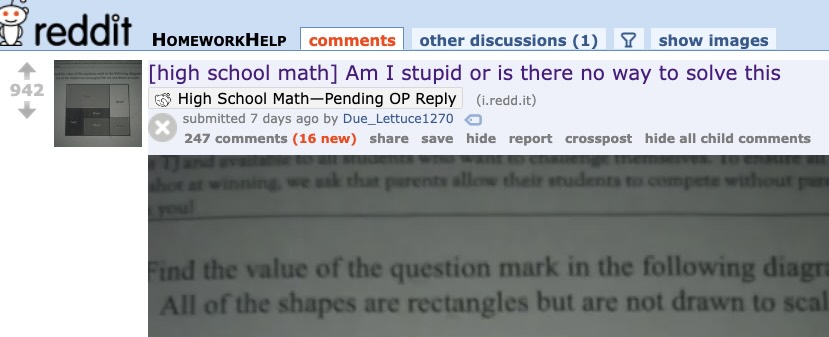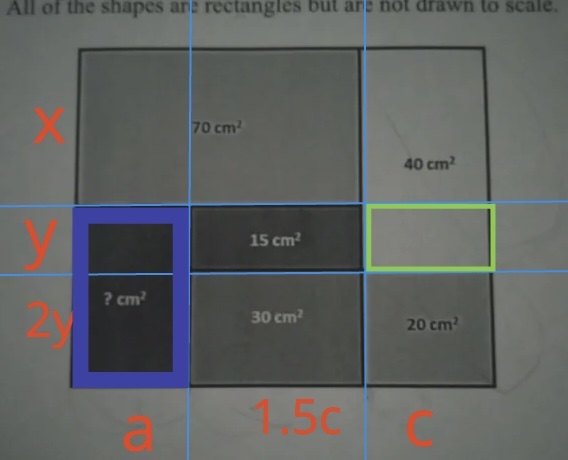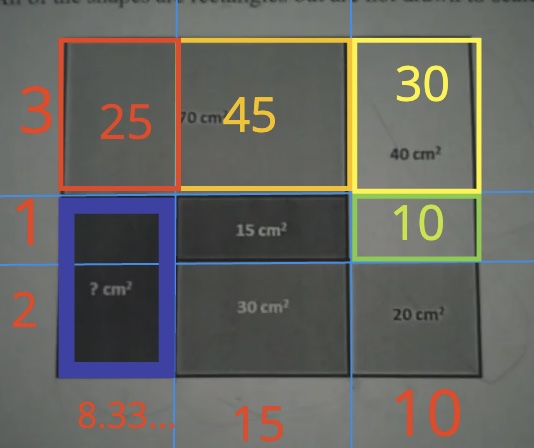
Ode to a good word problem
Whatever random number generator Reddit uses for a recommendation algorithm showed this to me.
And it brought me back to a million years ago when I was helping out in some math classes and saw how badly they used word problems.
Here was a typically awful word problem: “Sally has 15 apples, she divides them into 5 buckets, how many are in each bucket”. This trains students to think:
- The previous problems were solved by division, so I’ll do that here (it even has “divides” in the question)
- Assume they are divided evenly
- Always take the bigger number and divide by the smaller number
- Now do a dozen more of these in a row
And thus we learn that “word problems” are about ignoring the words and guessing at what operation to put between 2 numbers.
That’s bad. What word problems should be is the biggest step towards “when are we really going to use this?” In that they practice 4 very important steps:
- Express things mathematically
- Identify what we want to know
- Identify what we already know
- Keep throwing tools at it and keep track of how close we get
- Turn your answer back into words
- Optional step: go back and erase all the wrong steps that we took. This makes it look like we followed a direct path because we’re so smart
That is the essence of problem solving: turn something into something you can use your tools on.
Which is why I love problems like this. It’s not drawn to scale so we can’t use our usual toolbox and just measure it. Even better: if you don’t actually read the words you can try to solve a problem that is actually unsolvable! You can get the area but you ccan’t determine the lengths with the information given (I’ll explain why at the end).
So let’s express this mathematically — the messier the better, we don’t want to accidentally convince ourselves we know something. Usually some stuff from step 3 sneaks in here: in this case, since I know all the things are rectangles, I know all the lines are parallel or perpendicular and that stays true if I extend them.
Here’s our diagram covered in lines and all the distances given names:

What we want to find is the area of the blue rectangle and thus: a*(y+z)
Now let’s identify what we already know. So first let me tell you what I actually did: I filled a page with the equations of all the rectangles: 70=(a+b)*x, 15=y*b. Etc and started doing substitution. BUT let’s use that optional step 6 and pretend I had a few flashes of insight first and just start simplifying.
In terms of our tools, we only need 2:
- Parallel lines stay parallel
- And area=width*height — we’ll use that fact forwards & backwards
Right off the bat we can simplify some of these variables: if b*z=30 and c*z=20 then obviously b=1.5c. Likewise z=2y
This gets us closer to the answer. We want a*(y+z) which is now just a*(y+2y)=3a*y, one variable down!
And we just keep going making the right rectangles. For instance: this green rectangle has an area of cy, while its neighbour is 1.5cy so we know its area is 10.

And that makes the area of the yellow rectangle 30! (40-10)… And that makes the area of the purple rectangle since it’s the same height and 1.5 times as wide… And that makes the area of the red rectangle 25 (70-45).

Ok now we’re really getting somewhere but let’s remember what we’re actually trying to solve (to be honest, I’m not sure I needed to solve all of these sub-rectangles). This is the other thing I love about this word problem — real life problems often have a “wait, what were we trying to solve again?” stage too)
I want the area of the blue rectangle which is a*3y… and hold on, 3y=x. I know that because I have 3 rectangles of width c and 30=20+10. So I’m looking for a*3y=a*x. And I’m done, that’s 25! That’s the red rectangle I have already :)
Now the step I usually forget, actually answer the question:
The value of the question mark is 25. Although, for what it’s worth, I wish the questions asked “what’s the area” since “the area is 25cm^2” is a much more typical question.
Anyway, this is just a love letter to real word problem, but reading the Reddit thread I wanted to point out some not-math going on. A few people assumed it’d be a reasonable number, which I guess is fine for high school math but not something you can rely on for the real world. I also saw reference to it being “a square” when we’re told it’s not to scale in fact we can’t figure out what any of the sides are, here’s one that works with a short and squat 6cmx30.33…cm rectangle

Or we could make it taller:
 

Or we could make it a square.. which takes a bit more leg work since its area is 200cm^2, so we’re going to need the sides to both be 10*sqrt(2) and everything is messy but to 2 decimal places it’s:

Anyway, top notch math problem u/Due_Lettuce1270’s math teacher